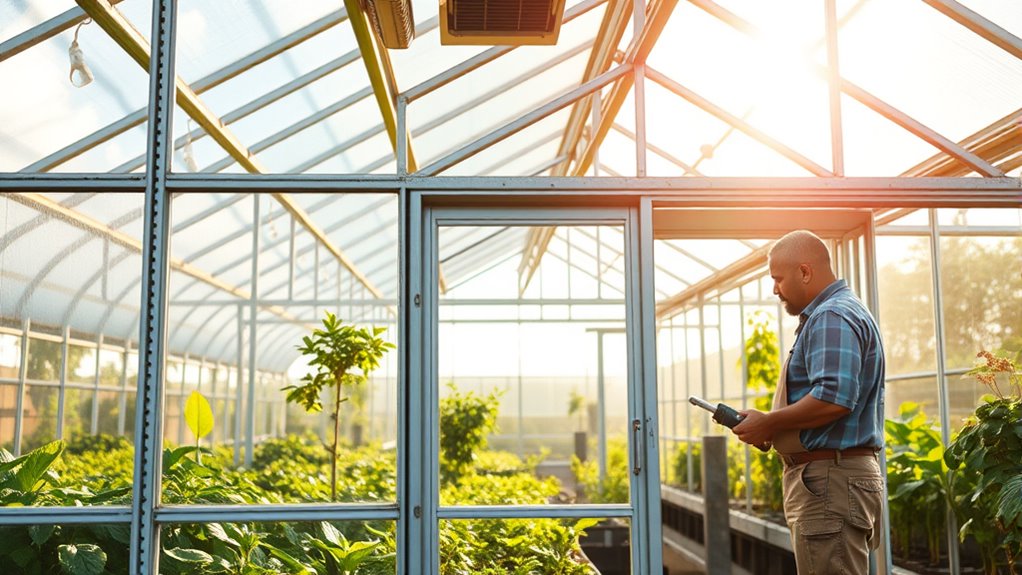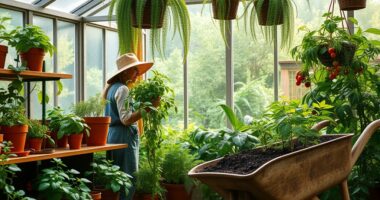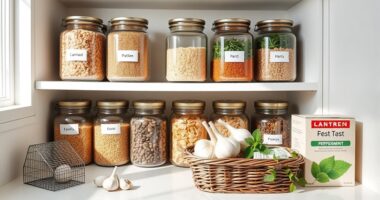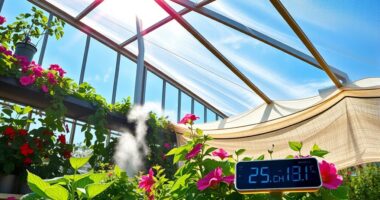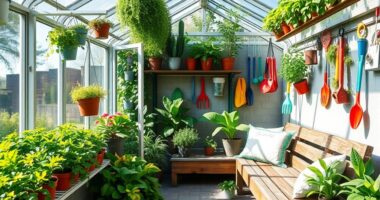To extend your greenhouse’s lifespan, regularly maintain ventilation systems by cleaning, lubricating, and replacing worn parts. Choose durable, weather-resistant materials like galvanized steel, polycarbonate covers, and high-quality seals suited to your climate. Monitor aging components and replace them promptly to prevent damage. Proper insulation and climate considerations help prevent deterioration. Consistent inspections, proactive repairs, and strategic material choices will keep your greenhouse thriving longer. Keep going to discover more tips for a lasting structure.
Key Takeaways
- Regularly inspect and clean vents, fans, and seals to prevent debris buildup and mechanical issues.
- Use high-quality, weather-resistant materials like galvanized steel, polycarbonate, and durable seals.
- Monitor and replace aging materials such as seals and coverings to maintain structural integrity.
- Incorporate proper insulation and climate-appropriate materials to withstand extreme weather conditions.
- Implement automated ventilation systems and proactive maintenance routines to reduce wear and prolong lifespan.
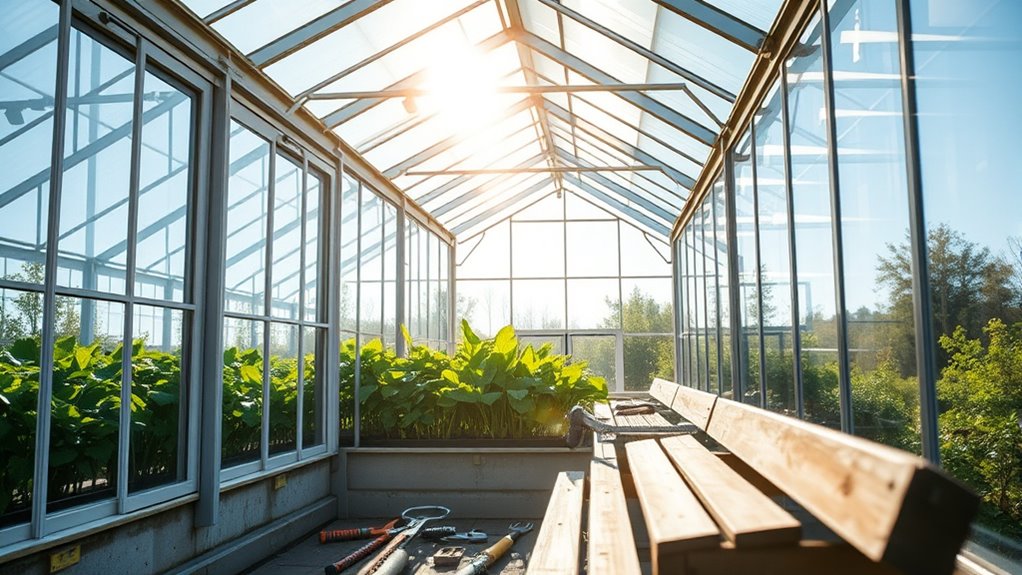
Achieving a longer, healthier life is within your reach if you adopt simple, proven habits. The same principle applies to your greenhouse structure. Properly maintaining your greenhouse ensures it remains durable and productive for years to come. One of the most critical aspects of this maintenance is ventilation. Regular ventilation maintenance keeps your greenhouse environment ideal, preventing issues like mold, mildew, and excessive humidity that can degrade the structure over time. Make it a habit to check and clear vents, fans, and exhaust systems regularly. Ensuring proper airflow not only protects your plants but also reduces the strain on your greenhouse’s frame, ultimately extending its lifespan. Additionally, monitoring the expiration of materials used in your greenhouse, such as seals and coverings, is essential to prevent deterioration caused by age or environmental exposure. Material selection plays a crucial role in the longevity of your greenhouse. Choosing high-quality, weather-resistant materials for the frame, covering, and seals can markedly reduce deterioration caused by environmental factors. For example, opt for galvanized steel or aluminum frames that resist rust and corrosion, especially if you live in a humid or rainy climate. When selecting covering materials, consider options like polycarbonate or tempered glass—both are durable and provide good insulation, resisting cracks and UV damage over time. Well-chosen materials minimize the need for frequent repairs and replacements, saving you money and effort in the long run. Additionally, pay attention to the seals and gaskets used in your greenhouse. High-quality, weatherproof seals prevent water ingress and air leaks, which can compromise the structure’s integrity and internal environment. Maintaining your greenhouse’s ventilation system isn’t just about cleaning; it’s also about ensuring the entire system functions efficiently. Regularly inspect fans, vents, and louvers for dirt, debris, or mechanical issues. Lubricate moving parts and replace worn-out components before they fail. This proactive approach keeps airflow consistent, preventing hot spots or damp areas that could cause structural stress or plant health problems. Also, consider upgrading to automated ventilation systems that respond to temperature and humidity levels. These systems can enhance airflow without requiring constant manual intervention, reducing wear and tear while maintaining a stable environment. Furthermore, selecting climate-appropriate materials tailored to your local weather conditions can significantly extend your greenhouse’s lifespan. Using proper insulation techniques can also help protect your structure from extreme weather, further prolonging its durability. Moreover, staying informed about climate considerations can help you adapt your maintenance routines and material choices effectively. Finally, your choice of materials should align with your climate and specific needs. For example, if you experience harsh winters, invest in insulated panels or double-pane glazing. If pests or extreme weather are concerns, select materials with added protective features. Incorporating proper maintenance practices can further extend the life of your greenhouse. Combining diligent ventilation maintenance with strategic material selection creates a resilient greenhouse that withstands the test of time. By paying attention to these details, you ensure your investment remains sound, your plants thrive, and your greenhouse stands strong for years to come.
Frequently Asked Questions
How Often Should I Inspect My Greenhouse for Damage?
You should inspect your greenhouse regularly to catch damage early. Aim for a thorough check at least once a month, especially after storms or harsh weather. Regular inspections help you identify small issues before they become major problems, promoting damage prevention. Keep an eye on the frame, glazing, seals, and vents, ensuring everything is secure and intact. Consistent inspections extend your greenhouse’s lifespan and keep it functioning most effectively.
What Is the Best Way to Prevent Greenhouse Pest Infestations?
To prevent greenhouse pest infestations, you should start with regular inspections to catch issues early. Use biological control methods, like introducing beneficial insects, to naturally manage pests. When necessary, apply chemical treatments carefully, following all instructions to avoid harming your plants or beneficial organisms. By combining these strategies and maintaining a clean environment, you’ll keep pests at bay and protect your greenhouse’s health and longevity.
How Can I Improve Ventilation to Extend Greenhouse Lifespan?
To improve ventilation and extend your greenhouse’s lifespan, focus on airflow optimization by installing adjustable vents and exhaust fans. Regular ventilation maintenance guarantees these systems work efficiently, preventing excess humidity and reducing structural stress. Keep vents clear of debris, check for leaks, and ensure fans operate smoothly. Proper airflow not only enhances plant health but also minimizes wear and tear on your greenhouse, helping it stay durable and functional for years.
Are There Eco-Friendly Materials That Last Longer for Greenhouses?
Did you know that eco-friendly materials like recycled plastics and bamboo can last up to 20 years? You should consider sustainable materials for your greenhouse, as they’re not only environmentally conscious but also more durable options. These materials resist weathering better and reduce maintenance costs. By choosing eco-friendly, durable options, you’ll extend your greenhouse’s lifespan and contribute to a greener planet.
What’S the Average Lifespan of Common Greenhouse Coverings?
The average lifespan of common greenhouse coverings varies based on material durability and quality. For example, polycarbonate panels typically last 10-15 years, while glass can endure 20-25 years with proper maintenance. Polyethylene plastic covers often last about 4-8 years. Your choice impacts material lifespan, so consider durability when selecting coverings to guarantee your greenhouse remains protected and functional for years to come.
Conclusion
Think of your greenhouse like a sturdy bridge—you want it to stand strong through storms and time. Regular maintenance, like checking for rust or leaks, keeps it resilient. I once met a gardener whose greenhouse lasted over 20 years because she treated it like a living partner, caring for it with the same attention as a cherished friend. With small, consistent efforts, you’ll extend your greenhouse’s life, ensuring your plants thrive for many seasons to come.
